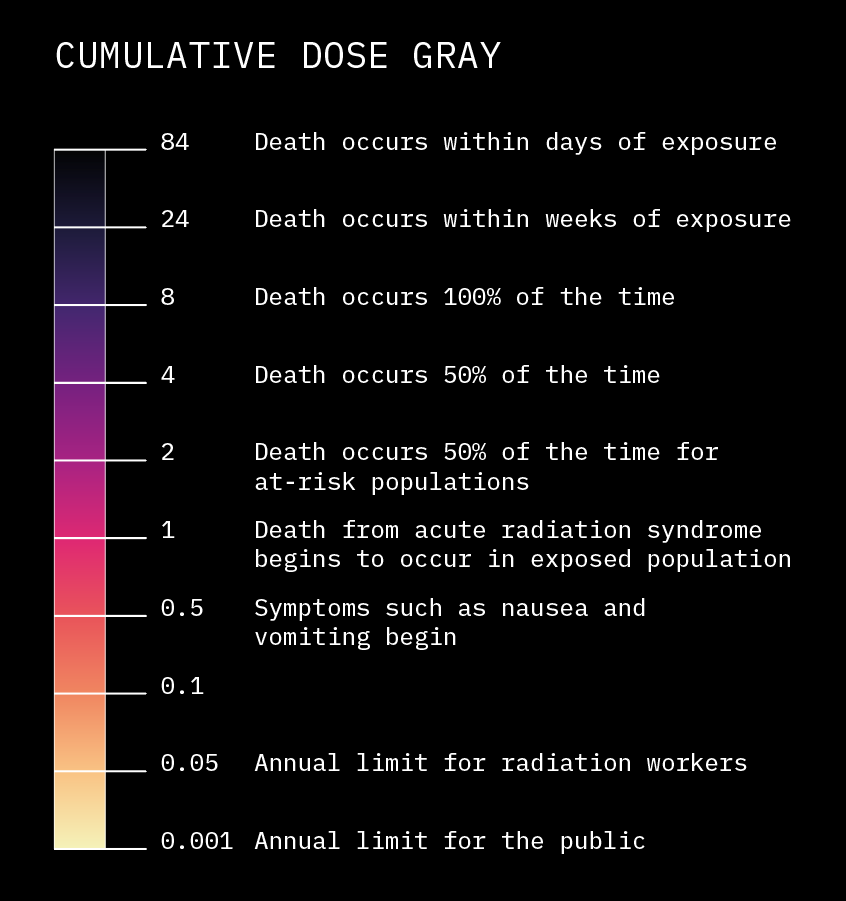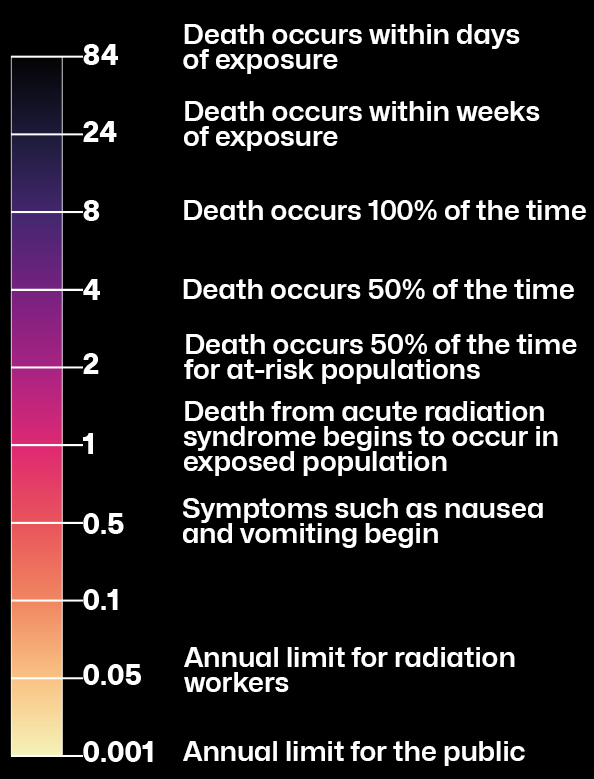To produce Under the Nuclear Cloud, we simulated the
radioactive fallout resulting from a concerted nuclear
attack on the 450 US missile silos 365 times, once for each
day of 2021.
Each silo is targeted with one warhead generating an
explosive yield of 800 kilotons of TNT equivalent. Each
nuclear explosion is assumed to take place at ground level
(known as ground bursts) and generates a 16.8-km tall
radioactive debris cloud.
The radioactive cloud is assumed to consist of micron-size
silica particles (density of 2.5 g/cm³) exhibiting a
log-normal size distribution with a mean diameter of 0.407
micron and a geometric standard deviation of 4. We use a
gravity-sorting algorithm to distribute the particles along
the vertical axis of the stabilized cloud according to their
size and the yield of the explosion.
To generate the fallout data, we use the US National Oceanic
Atmospheric Administration HYSPLIT atmospheric particle
transport code together with weather data from the Global
Data Assimilation System (GDAS1) one-degree archive.
Based on hundreds of simulations of the consequences of
nuclear attacks on the US missile silos, Under the Nuclear
Cloud presents for the first time the average consequences
for the public of a concerted nuclear attack on US missile
silos. It reveals the communities that are most at risk from
fallout in the United States and Canada given average wind
and rain patterns across North America.
Under the Nuclear Cloud is produced and supported by
the Brown Institute for Media Innovation and the Princeton
Program on Science and Global Security.
Generation of the HYSPLIT input files (control and initial
particle position files) and processing of the HYSPLIT
output data were conducted using the Nuclear War Simulator
software and QGIS.
Fallout are tracked across North America for 48 hours and
the outdoor cumulative dose to the public is integrated over
four days. The greater the dose, the higher are the chances
that deaths occur among the exposed population. According to
our calculations, 1 to 2 million people could die on average
as a result of a concerted attack on the US missile silos,
assuming they are able to shelter with food and water for
several days.

In practice, not all locations will be impacted at the same
time. The actual impact of a nuclear strike on the silos
will depend on the meteorology, including wind speed,
direction and rain, at the time of the attack. The map shows
the average outdoor radiation dose across North America
after four days of exposure, averaging the impact of
shifting winds across the 365 simulation we ran with weather
data from 2021.
Communities living closest to the silos could receive a dose
several times greater than what scientists consider lethal.
Most inhabitants of Montana, North Dakota, South Dakota,
Nebraska and Minnesota would get average doses greater than
1 Gy, causing fatalities from acute radiation syndrome,
especially among at-risk populations. Any dose above 0.1 Gy
would lead to
significant
increase in cancers in the exposed population. Overall, most
people living in the contiguous United States are in areas
where the average dose is greater than 0.001 Gy per year,
the current limit of exposure to the public. Our
calculations make no assumptions about access to health-care
or emergency services. Nor do they include other sources of
exposure such as prompt radiation from nuclear explosions.
To learn more about the methodology and software stack used
to generate the fallout data, see this related publication:
Philippe, Sébastien, and Ivan Stepanov.
Radioactive Fallout and Potential Fatalities from Nuclear
Attacks on China’s New Missile Silo Fields."
Science & Global Security (2023): 1-13.
To learn more about the effects of high radiation exposure,
see this
fact sheet
from the Center of Disease Control and Prevention.




